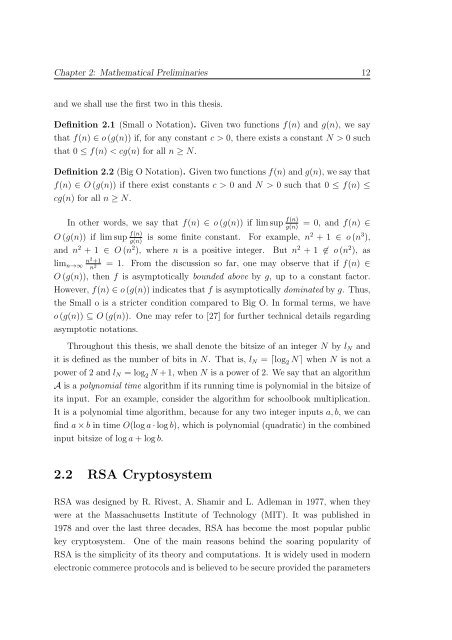Cryptanalysis of RSA Factorization - Library(ISI Kolkata) - Indian ...
Cryptanalysis of RSA Factorization - Library(ISI Kolkata) - Indian ...
Cryptanalysis of RSA Factorization - Library(ISI Kolkata) - Indian ...
You also want an ePaper? Increase the reach of your titles
YUMPU automatically turns print PDFs into web optimized ePapers that Google loves.
Chapter 2: Mathematical Preliminaries 12<br />
and we shall use the first two in this thesis.<br />
Definition 2.1 (Small o Notation). Given two functions f(n) and g(n), we say<br />
that f(n) ∈ o(g(n)) if, for any constant c > 0, there exists a constant N > 0 such<br />
that 0 ≤ f(n) < cg(n) for all n ≥ N.<br />
Definition 2.2 (Big O Notation). Given two functions f(n) and g(n), we say that<br />
f(n) ∈ O(g(n)) if there exist constants c > 0 and N > 0 such that 0 ≤ f(n) ≤<br />
cg(n) for all n ≥ N.<br />
In other words, we say that f(n) ∈ o(g(n)) if limsup f(n)<br />
g(n)<br />
= 0, and f(n) ∈<br />
O(g(n)) if limsup f(n)<br />
g(n)<br />
is some finite constant. For example, n 2 + 1 ∈ o(n 3 ),<br />
and n 2 + 1 ∈ O(n 2 ), where n is a positive integer. But n 2 + 1 ∉ o(n 2 ), as<br />
n<br />
lim 2 +1<br />
n→∞ = 1. From the discussion so far, one may observe that if f(n) ∈<br />
n 2<br />
O(g(n)), then f is asymptotically bounded above by g, up to a constant factor.<br />
However, f(n) ∈ o(g(n)) indicates that f is asymptotically dominated by g. Thus,<br />
the Small o is a stricter condition compared to Big O. In formal terms, we have<br />
o(g(n)) ⊆ O(g(n)). One may refer to [27] for further technical details regarding<br />
asymptotic notations.<br />
Throughout this thesis, we shall denote the bitsize <strong>of</strong> an integer N by l N and<br />
it is defined as the number <strong>of</strong> bits in N. That is, l N = ⌈log 2 N⌉ when N is not a<br />
power <strong>of</strong> 2 and l N = log 2 N+1, when N is a power <strong>of</strong> 2. We say that an algorithm<br />
A is a polynomial time algorithm if its running time is polynomial in the bitsize <strong>of</strong><br />
its input. For an example, consider the algorithm for schoolbook multiplication.<br />
It is a polynomial time algorithm, because for any two integer inputs a,b, we can<br />
find a×b in time O(loga·logb), which is polynomial (quadratic) in the combined<br />
input bitsize <strong>of</strong> loga+logb.<br />
2.2 <strong>RSA</strong> Cryptosystem<br />
<strong>RSA</strong> was designed by R. Rivest, A. Shamir and L. Adleman in 1977, when they<br />
were at the Massachusetts Institute <strong>of</strong> Technology (MIT). It was published in<br />
1978 and over the last three decades, <strong>RSA</strong> has become the most popular public<br />
key cryptosystem. One <strong>of</strong> the main reasons behind the soaring popularity <strong>of</strong><br />
<strong>RSA</strong> is the simplicity <strong>of</strong> its theory and computations. It is widely used in modern<br />
electroniccommerceprotocolsandisbelievedtobesecureprovidedtheparameters
















